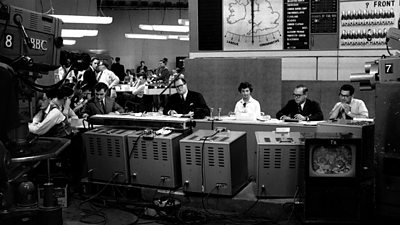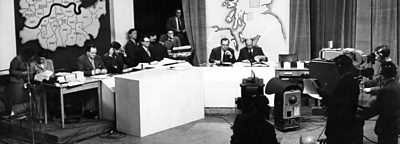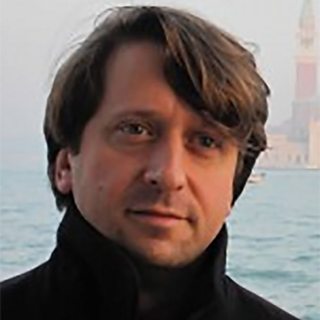After the experiments of the 1950 and 1951 elections the ±«Óãtv still faced considerable obstacles in reporting General Elections, notably no coverage of election campaigns and the so-called 14-Day Rule that prevented the ±«Óãtv from commenting on any issues being debated in Parliament.
Yet, this period was also marked by an increasing desire to make programmes that dealt with the 'current affairs' interests of audiences. Here the ±«Óãtv's Director-General at the time, Ian Jacob describes how these challenges resulted in the creation of editorial teams spearheading not just election output but iconic ±«Óãtv programmes such as Tonight and Panorama.
For the Head of Television Talks at this time, Leonard Miall, removing these obstacles was not an easy task.
With a regular audience of between 5-6 million, television was set to have a profound impact by the time of the 1955 General Election. Radio services were likewise radically altered to report, analyse and debate results through the night. For both, 1955 was a breakthrough year and their programmes were designed to demonstrate the power of broadcasting and its ability to host national political events.
There remained, however, a critical legal impediment to any further development of election coverage as the ±«Óãtv’s first Parliamentary Correspondent, E.R. ('Teddy') Thompson explains...
The absurdity of not being allowed to cover election campaigns was magnified by the launch in 1955 of Independent Television. A new post-monopoly consensus was now required. To this end David Butler, academic and ground-breaking statistical analyst on ±«Óãtv election night programmes since 1950, hosted a vital meeting in January 1958 at Nuffield College, Oxford.
Present were leaders and senior politicians from the main political parties and the heads of the ±«Óãtv, ITN and the ITA. The result was a loosening up of governing attitudes towards political broadcasting (see The Rules of Engagement). As David Butler notes...
Just a month after Nuffield, Granada Television (part of the ITV network) broke the taboo by covering in broadcast reports and debates the Rochdale By-Election. Representing the Liberal Party at Rochdale, and part of this campaign's wider public appeal, was ITN's own former news reporter, Ludovic Kennedy.
The recognition by politicians and broadcasters alike that the rules of engagement needed rewriting, combined with the pioneering approach taken by Granada and ITN, brought about new approaches in the ±«Óãtv's coverage of the 1959 election. The most prominent of which was the Hustings programme that followed the campaign trail for the very first time.
If the coverage of General Elections at the start of the decade had been tentative, by 1959 the ±«Óãtv had found a new confidence in its ability to offer audiences a much fuller palette of election programmes. Broadcasters were creating new ways of looking at and talking about politics on television and radio that sometimes left the political parties in their wake, as Stephen Bonarjee, Programme Editor, Current Affairs, explains...
This new spirit also brought renewed vigour and purpose to the ±«Óãtv's coverage of election night itself. No longer an experiment, these programmes were now an anticipated part of the election cycle to which huge resources and planning time were devoted.
Richard Dimbleby: The Perfect Professional
Richard Dimbleby’s career at the ±«Óãtv was a succession of ‘firsts’. The first ±«Óãtv journalist to accompany a royal tour, he reported on King George VI trip to Canada in 1939. The Corporation’s first war correspondent at the outbreak of the World War II, he was put in charge of the ±«Óãtv’s war reporting unit after the Normandy landings and was the first reporter to enter Bergen-Belsen concentration camp in April 1945.

In peacetime, Richard Dimbleby emerged as the voice of the ±«Óãtv, if not the nation, on state occasions, narrating Queen Elizabeth’s Coronation in 1953 and Winston Churchill’s funeral in 1965. And from 1955 he had anchored the ±«Óãtv’s television coverage of the General Election results.
In the opinion of Paul Fox, former Controller of ±«Óãtv 1, Dimbleby was ‘the perfect professional’ who had ‘an understanding with the audience that no other television reporter or presenter has ever had before or since’. His occupation of the election night hot-seat, however, had not been a foregone conclusion. Grace Wyndham Goldie worked extremely hard to convince those around her, including the Director-General Ian Jacob, that Dimbleby and not the ±«Óãtv’s Parliamentary Correspondent E.R. Thompson had the right mixture of journalistic instinct, gravitas and stamina to helm the programme.
Once in place, as Cliff Michemore recalled, Dimbleby made his presence felt: ‘At a professional level he made sure that you knew who was the boss. On election night programmes, for example, Richard let everyone know that he was in charge and very much so’.
Dimbleby was ‘the unflappable anchorman of the General Election Results programme, which went right through the night and required someone who was very well trained with news sense but also was at ease with the television camera’ (Leonard Miall, Head of Television Talks). In the three election programmes he hosted before his death in 1965 he had a profound impact on the establishment of election coverage as part of the core remit of a national broadcaster.
-
Annual television lecture given in his memory.
The Rules of Engagement
While the reporting of election results had developed in leaps and bounds during the course of the 1950s, the coverage of election campaigns remained non-existent. The 14-Day Rule and the Representation of the People Act bound broadcasters to an archaic presentation of politics and politicians. These external impediments co-existed with strongly held reservations by many in the ±«Óãtv about the acceptable limits of controversial broadcasting.
In January 1958 Nuffield College Oxford hosted a two-day conference on the subject of political broadcasting. Among those present were the ±«Óãtv Secretary, R.A. Butler, the leaders of the Labour Party, Hugh Gaitskell, and Liberal Party, Jo Grimond, the Director-General of the ±«Óãtv, Ian Jacob, and the Director-General of the Independent Television Authority. It was a pivotal moment in the evolution of political broadcasting as the opportunity to rewrite the rules of engagement was seized by politicians and broadcasters alike. Here, for the first time, you can read the agenda and minutes of that landmark meeting.
Election Report
Building on the success of the 1955 programme, preparations at the ±«Óãtv for the next election started early.
The planning process incorporated first-hand analysis of American election coverage and assessments of the challenge the ±«Óãtv was likely to face from its ITN competitor. Presenters and commentators were also engaged 18 months in advance.

For the first time the latest computer technology was used to speed up and elaborate the statistical analysis of the election results on television. Unlike the 1955 election, where declarations were phoned in from the ±«Óãtv’s News teams across London to Egton House (next to Broadcasting House), in 1959 teleprinters were installed into Studio G at Lime Grove.
And, for the first time as well, a national Swingometer gave audiences a visual glimpse of the way the election was going. All in all, 1959 was the most prepared the ±«Óãtv had ever been for a General Election.
To see how the ±«Óãtv planned and executed its coverage of the 1959 General Election results, read the internal report written by the programme’s producer (and future Controller of both ±«Óãtv 1 and ±«Óãtv2), Michael Peacock.
-
by Michael Peacock

